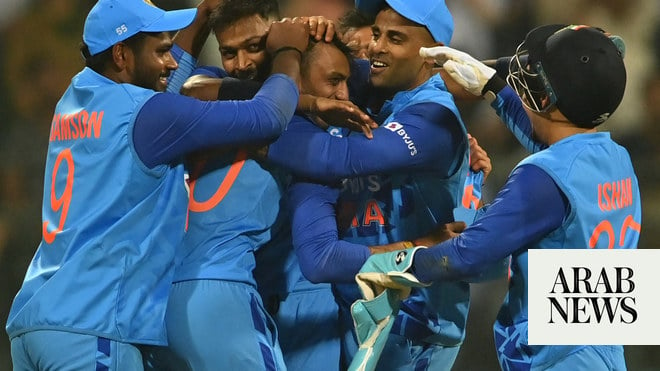
Sponsors, advertisers, broadcasters, players and administrators all stand to gain from the sport’s dominant format
As 2023 opens, a scan of the professional cricket horizon suggests that its profile is set to change significantly, perhaps fundamentally, in the next two years. Developments underway for almost 20 years are about to accelerate at unprecedented speed, without a braking mechanism in place.
For the latest updates, follow us on Twitter @ArabNewsSport
Previous columns have highlighted and documented the growth in T20 cricket in terms of the number of tournaments, the amount of money that they attract and their impact on the scheduling of the longer formats of the game. All of these features combine to create a disruptive dynamic for the traditional view of the game.
Yet, what is this traditional view? Is it Test match and domestic state/county cricket played out over four/five days in front of sparse crowds, at least in the case of the latter? If so, it survived the disruption brought about by the introduction of 50 overs cricket in the 1970s, absorbing it into existing temporal structures. At club level, in the UK, limited overs cricket of 40/50 overs cricket remains the norm. In Australian grade cricket, matches of longer duration are played over two days.
Does “traditional” refer to Test-match-playing countries? These are the ones which have to squeeze three different formats, at both international and domestic level, into each calendar year. So far, they have been able to assimilate T20 cricket into domestic structures, attracting nontraditional spectators, although how much some of them are focused on the cricket, as opposed to hospitality, is uncertain.
What is undeniable is that T20 cricket is popular. This is true across sponsors, advertisers, broadcasters, players and, crucially, administrators, promoters and funders. All of them stand to benefit financially. It is also popular amongst spectators, especially Indians, despite having to pay for the access to watch, either in person or on screen. It is unusual to find so many stakeholders aligned to such an extent. With the exception of India, the majority of national cricket boards are financially fragile, especially after the ravages of COVID-19. T20 franchise cricket provides some of them with a lifeline for a more secure financial future whilst, for others, it is a means of achieving greater recognition.
Currently, the Australian Big Bash is halfway through its schedule toward its final on Feb. 4, as is Super-Smash in New Zealand. The Bangladesh Premier League opens on Jan. 6, ending Feb. 16, with Pakistan and Sri Lanka players taking up the majority of overseas slots. Local interests own all seven franchises.
This is not the case for the UAE’s ILT20, opening on Jan. 13 and ending on Feb. 12. Five of the six franchises are Indian owned, the sixth is American. Overseas players are dominated by English, West Indians and Afghans. Indian ownership of South Africa’s new T20 tournament is total, in that existing IPL owners have bought all six franchises. The tournament starts on Jan. 10 and ends on Feb. 11. Two-thirds of overseas players are English, with West Indians being the next largest contingent.
In addition to the above, the eighth edition of the Pakistan Super League will start in mid-February and run until late March. There seems to have been some change to the original dates, so as to allow the ILT20 to complete and accommodate those players who play in both tournaments. The PSL has named 36 overseas players, including 10 from England, five from Afghanistan and four each from New Zealand, West Indies and South Africa.
It is apparent from the above that English players have an abundance of opportunities, as do West Indians. Afghan players have openings in the UAE and Pakistan. Opportunities are limited for Australians because of Big Bash and domestic cricket. The same applies to South Africans until after SA20 has finished. The full set of opportunities is skewed because contracted Indian players are not allowed to play in franchise competitions other than the IPL, whilst Pakistani players are not allowed into the IPL or, it seems, into tournaments owned predominantly or totally by Indian interests.
How that conundrum will be managed in the forthcoming franchise tournament in the US is unclear. After a series of delays, the professional Major League Cricket franchise tournament is scheduled to be held between July 13 and 30, 2023. Six teams based in Dallas, San Francisco, Los Angeles, Washington D.C., Seattle and New York City, will play 19 matches. By that time, the other franchise leagues will have finished, leaving a strong pool of players to be attracted, the only major diversion being the England versus Australia Ashes series.
The identities of all franchisees are still to be revealed, but a strong Indian involvement is likely. Multimillionaires Anurag Jain and Ros Perot Jr. own the Dallas team, which will be based at the former AirHogs baseball stadium, now the newly constructed Grand Prairie Stadium, Dallas-Fort Worth. Microsoft’s CEO Satya Nadella has invested in the Seattle franchise, whilst the existing Knight Riders franchise, already operating in Kolkata, Abu Dhabi, and Trinidad and Tobago, is investing in a new stadium in Los Angeles. This momentum is building toward the 2024 ICC men’s T20 World Cup to be held in the Caribbean and the US in June and July with 20 teams. In the US, cricket is set to challenge baseball.
Over the next 18 months, T20 will be the dominant format, representing an ever-growing proportion of cricket played at the professional level. The main target for this has been South Asia and its diaspora, but it is also the format used to spread the game globally outside of this market. Cricket stands at a watershed moment. Is it time for those traditionalists, who watch only Test and longer form domestic cricket, to admit and accept that their time is up, that the game has moved on, structurally to T20 and geographically to India, leaving them behind in its wake? The only foreseeable brake on this trajectory is the willingness of the longer format to make itself more appealing whilst it still has the chance.












